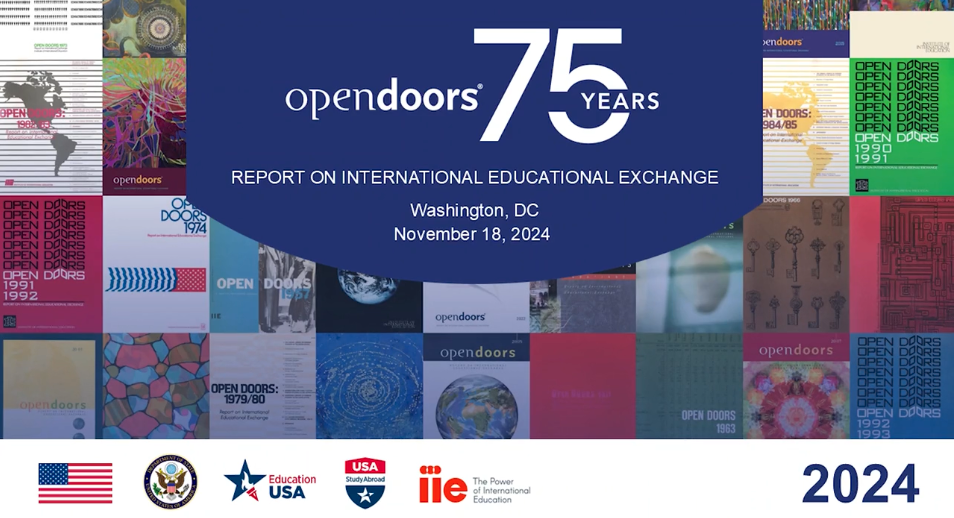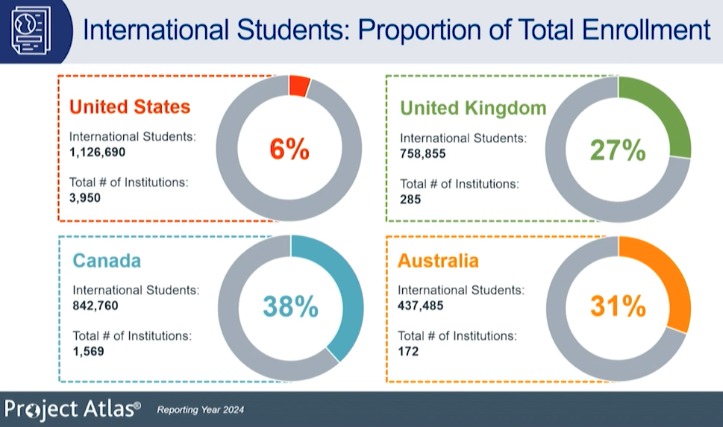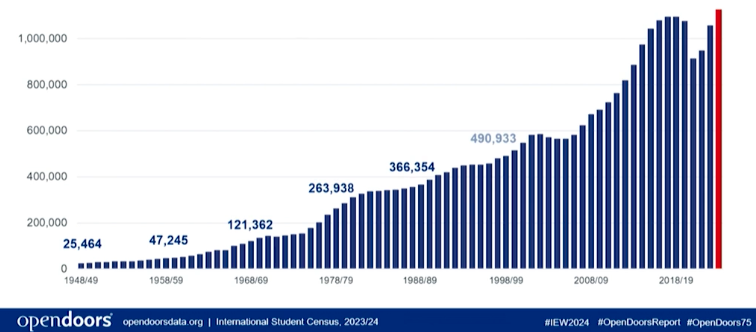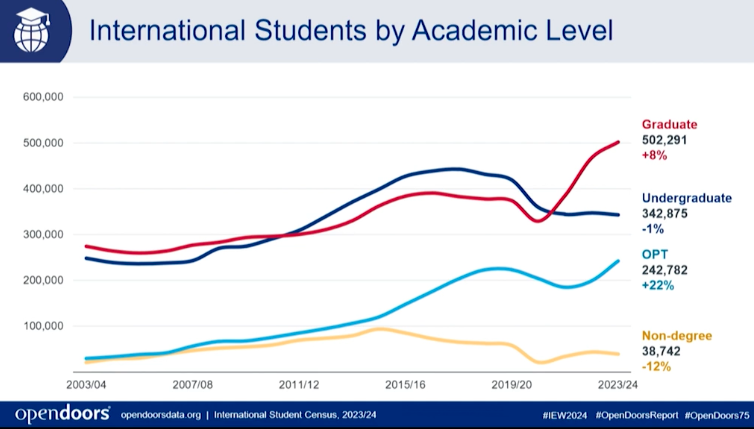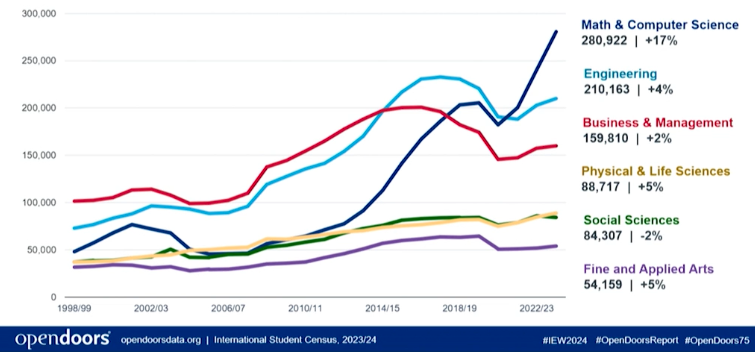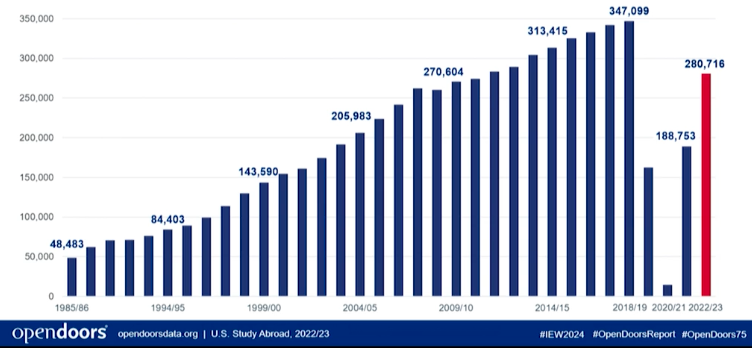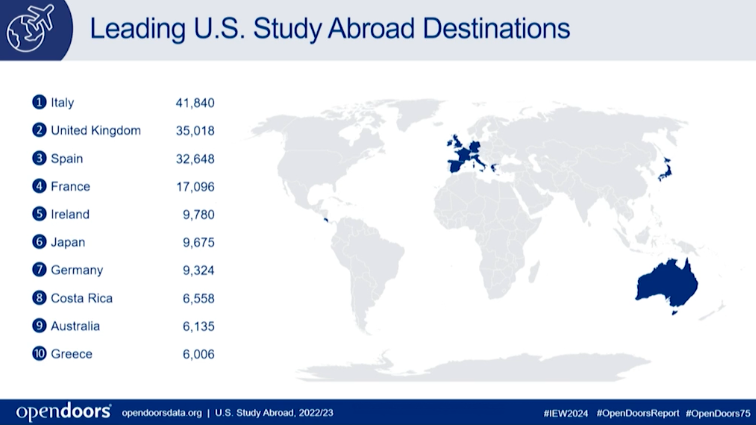How is international higher education enrollment changing?
Today I’m blogging the release of new research into this subject. This morning the new Open Doors report appeared, from the Institute of International Education (IIE) and the United States Departments of State and Education. I’ll share notes and a summary along with some reflections.
This post is done quickly, basically a live-blog of the announcement, so it might appear to be more telegraphic and hasty than usual. I grabbed screen captures of especially useful charts, graphs, and maps.
6.9 million students: that’s how many students crossed international boundaries for post-secondary education around the world, according to opening remarks from IIE’s CEO, Allan Goodman. He sees that number reaching 10 million by 2030. Right off the bat Goodman says this is a big opportunity for American campuses, since our domestic enrollment is weakening and we have ample capacity.
Later in the session, Leah Mason, Deputy Director of Research, Evaluation & Learning, IIE, shared more data on this score. She presented IIE’s Project Atlas‘ latest to indicate which nations were the leading destinations for international students. The United States leads with about 16% of the global total:
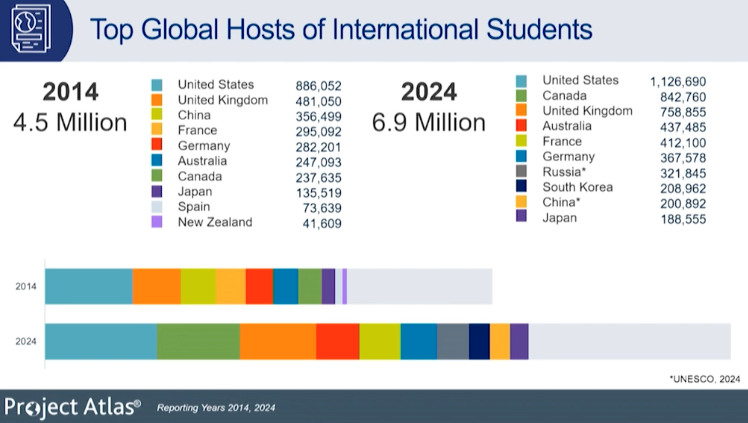
Don’t miss Canada’s spectacular rise!
I’ll note the top 5 are all anglophonic nations.
Mason then showed what proportion of some of these nations’ total postsecondary student body, and three nations host a mind-blowing number of international students:
Next, Mirka Martel, Head of Research, Evaluation & Learning. IIE took the stage. She revealed that 1,126,690 international students studied at American institutions in academic year 2023-4, a 7% increase from 2022-3. That’s the highest total IIE has ever found and a recovery from COVID-era drops. Martel added that “the US remains the top host of international students worldwide.” That represents a continuation of a very long term trend:
Very interesting differences in academic level appeared, with grad students the largest and growing number. Undergrads actually declined, apparently because of “COVID cycling.” Note the rise of OPT, too:
Where do international students come from? Mostly east and central Asia. India is the new leading source, sending 331,602 students, a big increase since COVID, and mostly grad students and OPT. Next is China, with 277,398. South Korea is in a distant third place with 43,149 students; interestingly, most of them are undergrads. Overall, 6% of students at American campuses are international. 44 US states saw those numbers rise over the past year, led by California, New York, Texas, Massachusetts, and Illinois.
What are international students studying? STEM fields are the most popular, with over half (56%) taking classes in those domains. 25% are studying math and computer science alone:
EDITED TO ADD: IIE kindly responded to my email query about the humanities and pointed me to their data explorer site, where I found this number: 15,937 students working on “English language and Literature/Letters; Foreign Languages, Literatures, and Linguistics; Philosophy and Religious Studies; Theology and Religious Vocations.” That’s a 1% increase from the previous year. My back of the proverbial envelope math says 1.4% of foreign students study the humanities in the United States.
There was a quick note about funding, but it wasn’t clear. 55% of students self-fund their study, but does that include loans?
Next, IIE shared early data from fall 2024. First figures show continued rise of international students, but only by 3% this time. Undergrad numbers actually grew, as did OPT, while grad numbers dipped down.
Then the presentation switched to American students studying abroad, with Julie Baer, IIE’s Research and Learning Lead. The past two years have seen increases after study abroad nearly ceased during COVID, but numbers haven’t yet reached pre-pandemic levels:
American students mostly go to Europe:
Two-thirds of Americans studying abroad go for 8 weeks or fewer. Demographically, students heading abroad are fairly diverse along racial lines, but not so much as the overall populace. IIE didn’t share data on student gender or other dimensions.
Summing up, some quick thoughts: this snapshot shows international study growing around the world, with some interesting sending and receiving patterns. Anglophonic nations remain top destinations, while India and China lead the world in shipping students abroad.
Note the fields of study trends, which resemble American ones, just more so. STEM, business, and allied health predominate. (I do wonder how many international students study American culture in the US, British studies in the UK, and so on.)
Some countervailing themes: I note the proportional decline in Chinese numbers going to the US and elsewhere. Increased Cold War 2.0 tensions may depress that further. Canada and Australia are both cutting back international enrollment, which is an opportunity for British and American colleges and universities, as Allan Goodman said at the start.
The elephant which just stomped into the room is, of course, the impending Trump administration. As I said in that linked post, we could see Trump 2.0 scaring off international students for various reasons. However, Trump was close to India’s government, so perhaps the rise of Indian students heading to the US will increase even further.
A bigger elephant is climate change. There was no mention of international study’s carbon footprint in the IIE presentation, nor have I seen any in discussions so far. That’s a significant amount of jet travel.
I’ll update this as more information comes in. Thanks to the IIE for an open and data-rich presentation.

